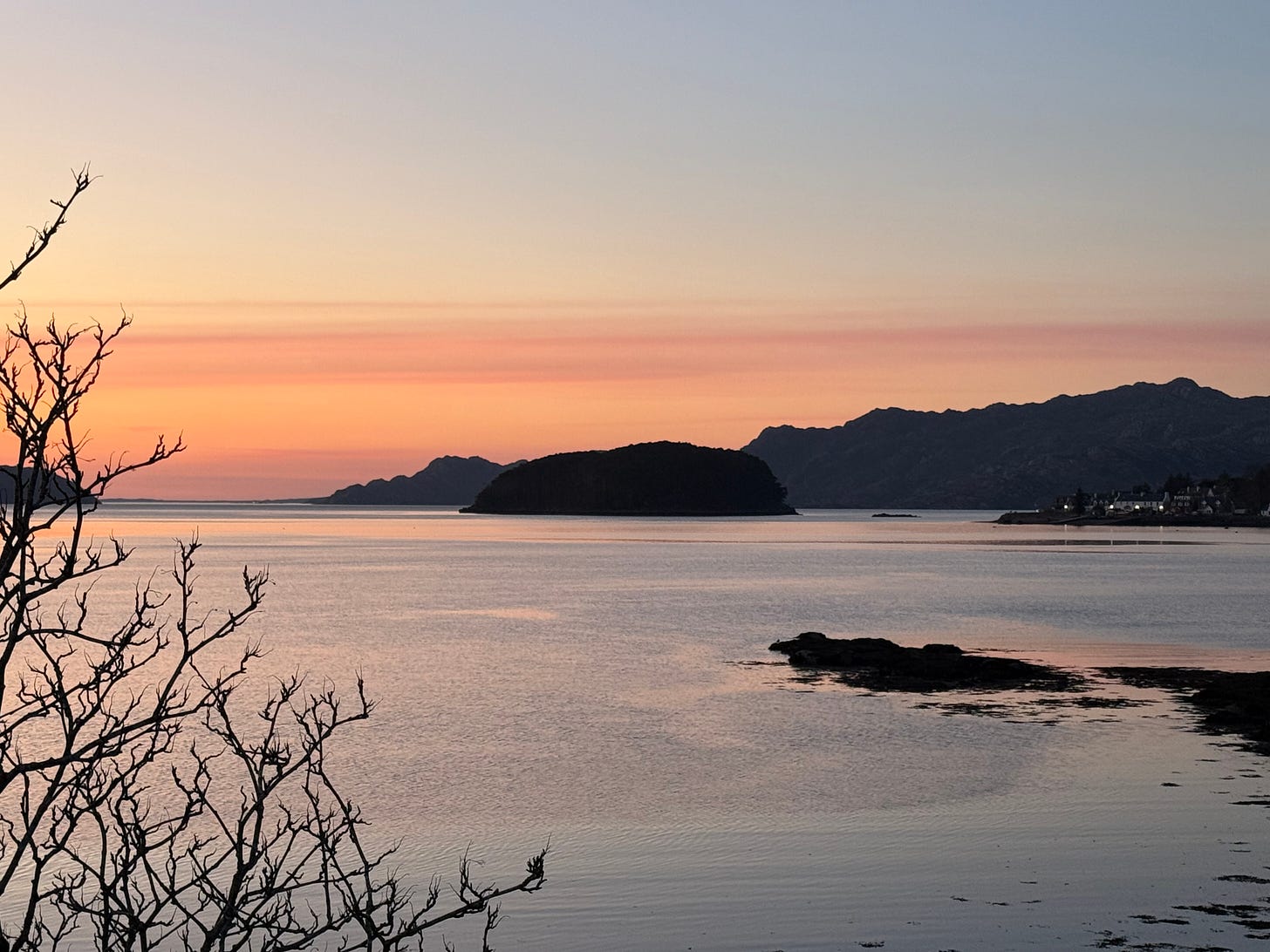It always makes me smile when things just kinda sorta happen - serendipity! Virtually meeting a kindred spirit on LinkedIn was the starting point of what would eventually lead me to roam Kinloch Woodlands, one of SCOTLAND: The Big Picture’s Northwoods partners, and one with imposing views not easily surpassed.
Lucie Wuethrich lives in Scotland and fiercely advocates (howls) for the wolf in Europe - and against any country lowering protections and slaughtering entire packs of that amazing keystone species. The fight for the wolf was how we found each other on LinkedIn. When I planned my rewilding fact-finding mission in Scotland, I got in touch and she immediately connected me with Claire and Richard Munday, who had begun to restore the Kinloch Woodlands in 1992 - and who lived, who knew, just around the corner from Lucie!
Until the early nineties, the 3’700 acres bought by the Mundays were part of the Lochcarron shooting estate. The new owners immediately switched gears. They created a holiday business and, instead of running the state in traditional ways, they began to restore the lands that had been degraded by sheep and deer, logging and fire over the course of centuries. Richard Munday wrote the following about their first impressions:
Apart from the small remnant birch wood in lower Corrie Kinloch, only a handful of mature trees remained. The contrast with the magnificent Caledonian pine forest on neighboring Ben Shieldaig, where the trees had been largely protected by its steep slopes, could not have been greater.
I have to admit, I was somewhat exhausted by the time I arrived at the Kinloch B&B. Not so much because of the long drive, but because of the many people I had already met during this trip. Every meeting another highlight, with more inspiration, more learning and, inevitably, more for me to write about. Until that moment I had already met with (and written about) Peter Cairns, James Shooter, Stef Lauer and Mark Hamblin, Steve Micklewright, David Hetherington, Alan Watson Featherstone, Daniel Holm, Sam Hesling, as well as Malccolm Turner and Caz Austen.
But when I got out of the car, whatever tiredness had been there, evaporated with the clear air, the wonderful weather, the amazing vistas - and the welcome by my host, the passionate nature restorer, soup genius and joyfully tangential (she’ll know what I mean) Claire Munday. She told my about the past decades, about the work with Kinloch Woodlands, about life’s many changes that came with moving to this marvelously remote part of Scotland.
The kids went to school in Shieldaig and Claire worked as a nurse for ten years. They were fully integrated in the community before long, and yet, Claire recounted, it did take years for some of the minds more set in traditions to fully accept the Mundays and their differing, new ways of managing land.
By the early 2000s, 1’000 acres of Kinloch had been fenced and half a million native trees had been planted within the enclosure. They created clusters, or islands, of Caledonian pine, alder, willow and downy birch. Deep peatland was left untouched, but along the banks of burns they gave nature a helping hand. With the deer fence protecting both planted and naturally seeded saplings, the transformation was well underway.

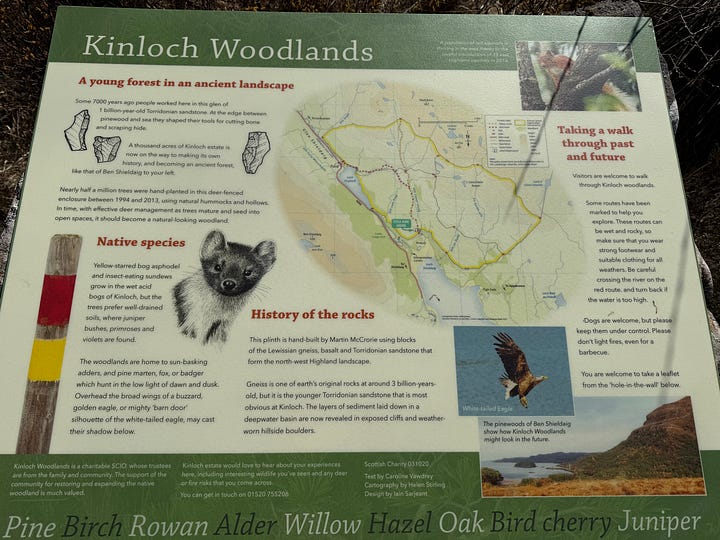
The day after my arrival at Shieldaig, Lucie came to meet me at Kinloch B&B … by kayak! You see, her house was located just beyond the next bay and so that’s how she and I met for the first time in person - a huge bear hug was in order. Claire took us for a walk along the river, then brought us into the fenced Kinloch Woodlands. It’s been twenty-five years since that last deer fence has gone up and you can see nature alive and well and growing vibrantly. The effects of freedom from intense deer and sheep browsing are evident everywhere.
By now, wildlife has rediscovered Kinloch Woodlands. Red squirrels had been reintroduced to the area by Trees for Life in 2016 - and with tree connectivity expanding, Kinloch has also become one of their places. Badgers are back, the once rarely seen buzzards are common once more, and many smaller birds and insects thrive. Oh, and the white-tailed eagles that have been nesting on Shieldaig Island since 2009? They regularly soar above the Kinloch Woodlands (yep, we saw them) - and they occasionally swoop down to feed on deer carcasses.

Deer, in healthy balance, are important for the Highlands’ nature - but without natural predators, and with shooting estates keeping numbers artificially high, their browsing makes the natural regeneration of woodland near impossible (except for places deer avoid because they’re too steep). One day the fences around Kinloch Woodlands will come down but, for now, culling remains a necessity.
You may ask, “Why is culling necessary if there are fences?” Well, I can assure you that those fences work like a charm, they’re high and they’re solid. But there remains one way those deer, salivating at the idea of a myriad of saplings, can still get in - and that’s by swimming! Where the fence meets Loch Dughail, enterprising deer occasionally take the plunge for a trip into Kinloch Woodlands. Deer numbers are low these days - they shoot less than twenty annually. The local community benefits from some of the venison, while the occasional carcass is also left behind, as mentioned, as a buffet for eagles and other ravenous wildlife.
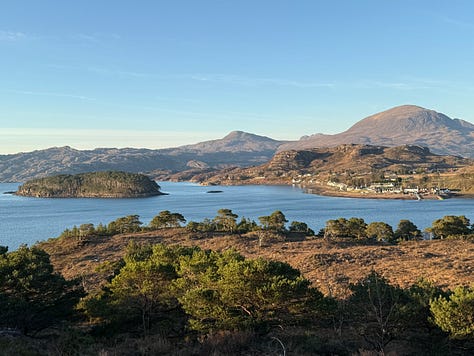
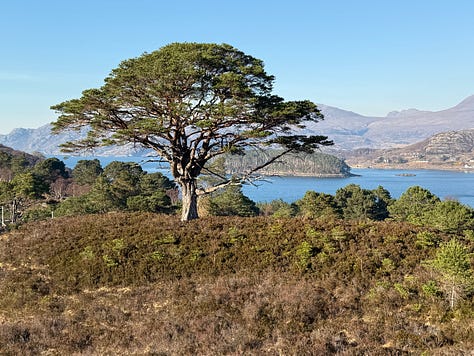
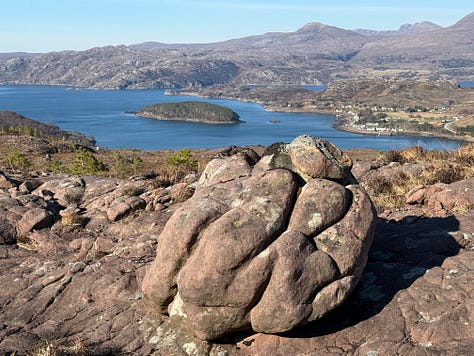
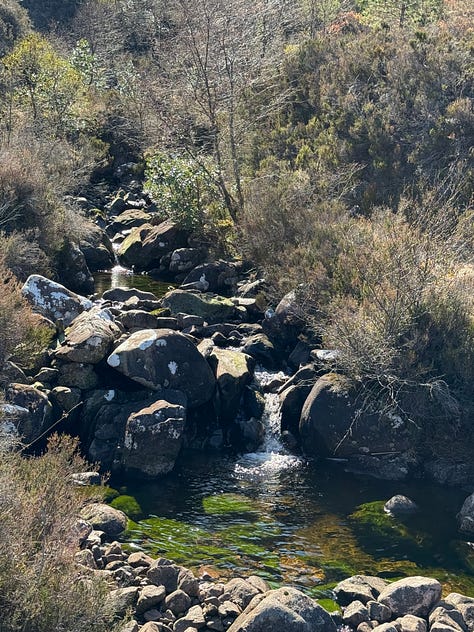
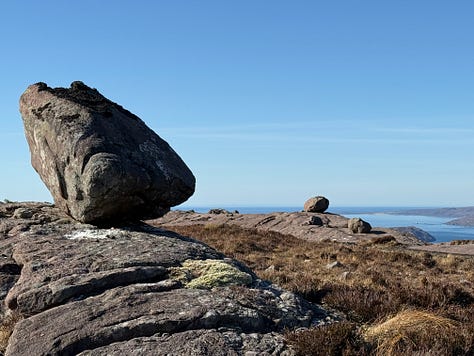
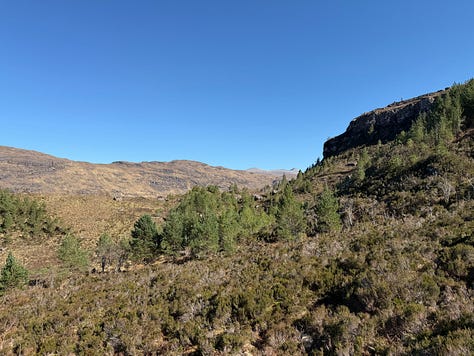
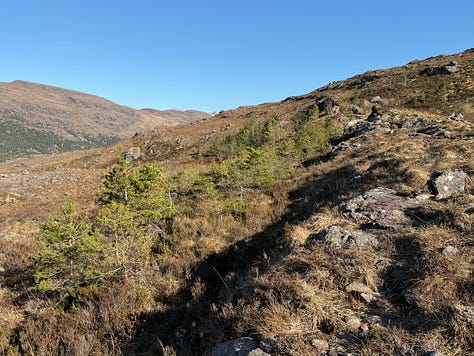
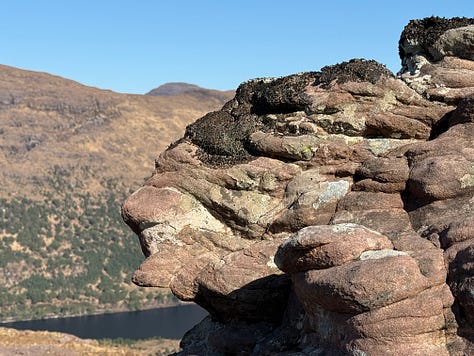
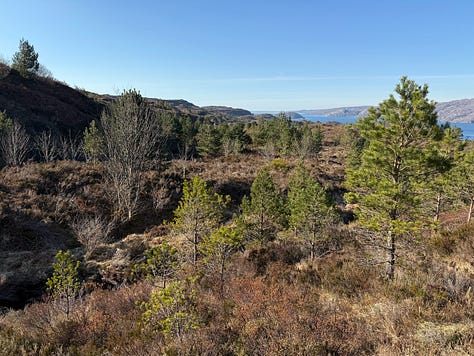
Lucie and I explored Kinloch lands for most of the day, climbed higher and higher, enjoyed views as far as the Outer Hebrides - and we kept a close eye on nature all around us. You could see the clusters of the trees that had been planted long ago, growing nicely. And there were lots of examples of natural regeneration. There were also many barren, wind-swept places and, right behind those ridges, protected from the wind, you’d have schools of young trees rising merrily. There was deep peat in places and rock formations from and for the ages - stunning geology all around us.
As I’ve seen in many other places by now, rewilding efforts often - and rightly so - take on a community aspect. After all, we are part of nature and it is key for local communities to feel connected to the land, with a sense of pride and care. What began as a family affair with the Mundays in the nineties, eventually became a charitable trust and then, in 2016, an SCIO (a Scottish charitable incorporated organization). Of the ten trustees, three have special expertise, while seven are from the local community (and that includes Munday family, of course).
And there’s more: Kinloch Woodlands’ most recent partnership is considered the first of its kind in Scotland - that of a university working with a community landowner to restore native woodland. To deliver on its pledge to be carbon neutral by 2040, the University of Edinburgh works with a range of partners and landowners. For Kinloch Woodlands and the Shieldaig community this means that they “will receive financing over the course of the project to help with costs associated with the running of Kinloch estate and to reinvest into the Shieldaig community … There will be educational opportunities throughout the project, with plans to involve Shieldaig Primary School in various projects. Rewilding efforts and habitat management will also create a living laboratory for long-term environmental monitoring, academic research and hands-on learning.”
The future’s never certain (and a good thing that is, too - how boring life would be) and so, as always, we shall act with hope toward the future would like to see come true. In the absence of certainty, we come up with visions and strategies and plans, and sometimes things work out that way. If you think way into the Kinloch Woodlands’ future, you may see these lands free of fences and rich with woodland. You may see healthy numbers of deer, kept in check and in balance by lynx. You may see regenerative land and forest management that ensures long-term sustainable benefits for the local community. Richard Munday put it like this:
“Looking to the future, the aim will be to continue the restoration of the natural habitat in as natural ways as possible and to the benefit of the Shieldaig community.”
And that’s that for today. Hope you’ve enjoyed exploring Kinloch Woodlands with me.
Cheers,
PS: I’ve wanted to add a few more Kinloch Woodlands images because, heck, it truly is a beautiful place. These images are by SCOTLAND: The Big Picture’s Peter Cairns and Mark Hamblin. Enjoy!



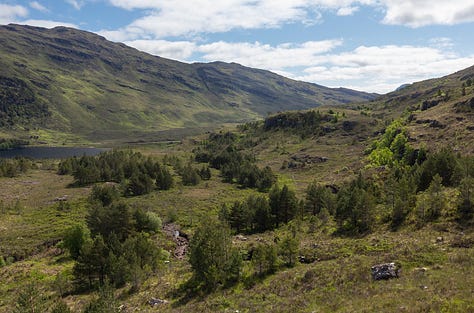





If you enjoy the Rewilder Weekly …
… consider supporting my work. Your paid subscription will help generate the funds needed to realize a unique rewilding book I’m working on. And, of course, that paid subscription also ensures that the Rewilder Weekly will always keep going for those who cannot afford to pay. A thousand thanks!







